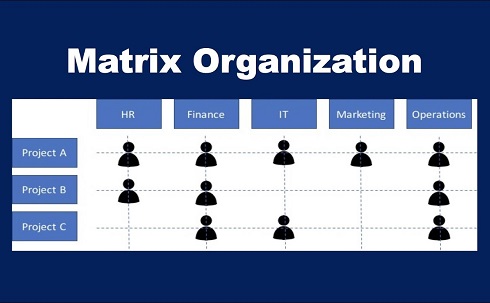Matrix Organizational Structure in 2024
Matrix Organizational Structure – Traditional organizational charts and hierarchical company models are familiar to the majority of managers and employers.
These tools are used to show how a company’s chain of command is organized.
They outline which staff members answer to which managers as well as how duties, responsibilities, and job functions are structured to take advantage of business development prospects.
One chain of command is typically included in traditional organizational models.
The management roles are established, and it is easy to understand which employees report to which manager when there is a Chief Executive Officer at the top of the chart.
According to the organizational structure, each level of employees reports to the manager immediately above them, and everyone eventually reports to the CEO.
The traditional corporate hierarchy is unquestionably effective in some settings, but it is less effective in businesses that place a high value on cross-functional teamwork.
An effective matrix structure is often preferred in these kinds of companies.
A matrix organizational structure is particularly helpful for businesses that distribute resources and personnel among numerous locations.
Workers under a conventional hierarchy answer to a single manager or boss. Employees in a business with a matrix organizational structure must answer to both a functional manager and a product/project manager.
While the functional manager is in charge of functional, or routing, tasks, the product/project manager performs the duties of a traditional project manager.
A matrix organizational structure can help the business harness the strengths and abilities of its employees when skills need to be shared across sites or departments to accomplish a goal.
In a matrix organization, employees frequently perform many roles and work across various corporate divisions. For instance, a social media manager will probably need to communicate with staff members from sales, PR, digital marketing, and communications.
What Exactly Is an Organizational Matrix Structure?
An example of a blended organizational structure is the matrix organizational structure. Large, sophisticated project management is where it excels.
Although a functional hierarchy still exists, the project manager’s work is frequently given more credit than it would in a conventional hierarchy.
The project manager is in charge of managing the projects that fall within their purview and allocating the appropriate resources.
Managers are able to take a more comprehensive approach to problem-solving when they share skills and responsibilities across the organization.
An organizational structure with numerous hierarchical layers can prevent a project team from effectively achieving its goals.
Employees can more easily manage complex projects by using a matrix organizational chart, which enables them to react rapidly to other team members from various disciplines. Teams can work more flexibly under this arrangement, which makes it easier for them to meet deadlines.
Each team member is answerable to at least two people, typically a project/product manager and a functional manager, as was already mentioned. There are several chains of command and no set ratio of power between the various managerial positions. It is required of managers to work dynamically and fluidly.
Example of an Organizational Matrix
CEO Product and project managers, as well as functional managers
Team members 1 through 5 (all of whom are subordinate to both the project/product manager and the functional project manager)
Each team member has two line managers reporting to them, each with their own duties and priorities. Each manager is directly responsible to the CEO, who is the only employee with a set management position.
A matrix organizational structure is ideal for teams that have several active projects at once. Existing workers can be used in accordance with their skills and personal characteristics rather than having to form numerous distinct teams for each project.
Along with their regular duties and activities, the managers will lead them through the many components of each particular project.
What Kinds of Organizational Matrix Structure Exist?
There are three types of matrix organizational structures: weak, balanced, and powerful. These descriptors are related to the project/product manager’s level of authority.
- Weak matrix: The functional manager is given more power
- Strong matrix – The project/product manager is given more power
- Equal power is granted to the functional manager and the project/product manager in a balanced matrix.
Poor Matrix
The project manager may be perceived by the functional manager as a threat to their ability to accomplish the functional objectives of their service or department in a weak matrix.
This may be a problem if the functional manager and project manager have objectives that are significantly dissimilar.
Without a common goal, the managers risk operating in opposition to one another, which could result in a power struggle.
In order to prevent this, the functional manager and project manager should collaborate early on to talk about how to connect their specific goals to the larger goals of the company.
Integrated Matrix
The project manager and functional manager may become confused about who is in charge of which tasks in a balanced matrix.
Employees may be impacted by the same problem. There will be a breakdown in communication if staff members are confused of who to contact or if they share information with others who don’t require it.
To solve this, a RACI chart can be used. Each team member should be assigned the letters R, A, C, and I for every area of the project:
R – Participates in decision-making and is in charge of finishing the work. This can be distributed among several team members.
Accountable for achievement. Although it may be shared, this is typically given to one person.
C stands for the project’s consultant. Although this person has the necessary skills to finish the project, they are not in charge of making decisions or managing day-to-day duties.
I am knowledgeable folks. Although they are not actively involved in the project, these persons nonetheless need to be informed of its progress.
The reporting structure is simpler in a conventional hierarchy. The hierarchy makes it obvious which employees report to which managers, and the manager is responsible for the team’s overall performance.
Powerful Matrix
The functional manager may believe that there is insufficient communication coming from the project manager in a strong matrix. Project prioritization and resource allocation are typical topics for communication disputes.
Creating a team charter is a helpful method to define priorities, decision-making responsibilities, and resource allocation.
What Benefits and Drawbacks Does a Matrix Organizational Structure Offer?
Advantages
Businesses can gain a lot from utilizing a matrix organizational structure, including:
Project goals that are transparent and clear – Teams in a matrix organizational structure are better able to meet project-based work goals than teams in a standard organizational structure.
Open channels of communication throughout the company – With a matrix structure, communication frequently gets better, which makes employees feel more “in the loop” regarding overall business operations and goal progress. Knowledge is easily transferred between departments, which aids in team barrier removal.
greater prospects for working in teams – A matrix organizational structure promotes cross-department collaboration, which helps staff members grasp the opportunities and challenges faced by their colleagues.
The project team can get aid from highly qualified employees within the functional divisions, so there’s never a shortage of “expert” individuals without having to hire more people.
More effective time management – Teams can streamline processes and decrease the need for duplication of effort by cooperating across departments.
a consistent work atmosphere, which raises employee satisfaction levels. Employees who work in matrix teams are more likely to feel invested in the company’s goals, which will result in higher levels of “buy-in” and better contributions.
Additionally, employees have more chances to broaden their experience and expand their skill sets, which enables them to move closer to their professional development objectives.
Disadvantages
There are a few drawbacks to a matrix organizational structure that you should take into account:
Team conflicts are probably going to happen, especially if employees start to favor one boss over another. In a conventional organization, each business unit or department is overseen by a single manager.
Multiple managers overseeing the same workforce can complicate working relationships and raise the likelihood of management and employee conflict.
The boundaries between work roles tend to be more hazy under a matrix organization, which might lead to conflict if individual duties are unclear.
It is difficult to plan and set up a matrix structure. It takes longer to plan since there are more difficulties.
The amount of work that staff members must accomplish in addition to their project-based responsibilities can be more. This may occasionally result in staff burnout or missed or forgotten tasks.
Different management philosophies among managers can make them incompatible. This can still be a problem in a typical organizational structure, but it becomes more challenging to solve when managers are responsible for both line-management and direct reporting to them.
Managers may have competing goals, which can cause conflict. Again, traditional hierarchies can also exhibit this.
Prior to taking action, decisions must be approved by a number of persons, which might cause delays.
It may be challenging to create and come to an understanding on priorities because the functional manager and project manager may have distinct personal goals.
Final Reflections
You need to implement a clear corporate goal and clearly defined communication channels for a matrix organizational structure to be successful.
Your company’s success is largely dependent on the hierarchy of organizational structure you choose. Your business strategy, organization size, project objectives, and worker demographics will all influence the best structure.
The financial effects of implementing a matrix-style structure should also be taken into account, as hiring additional individuals for managerial positions is likely to have an impact on the company’s bottom line.
You need to implement a clear corporate goal and clearly defined communication channels for a matrix organizational structure to be successful.
The first step in deciding whether to create a matrix organizational structure is to assess your current team and resources.
Take into account the demands and skills of the company and the employees, as well as the schedule of impending tasks and due dates.
An effective option for your company may be a matrix organizational structure if it is engaged in a number of large-scale initiatives. However, you should also take into account how motivated and experienced your team members are.







